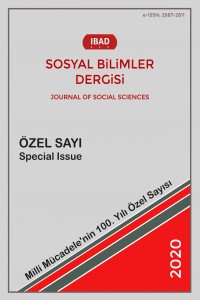Abstract
Design education is inspired by many different areas in the form creation process. Biomimicry, one of these areas, combines nature and design. In some nature-inspired works, it was seen natural forms were copied and directly transferred to the final design. The products that emerge with this approach are imitations of nature. In the design process, it is possible to be inspired by natural forms without imitating nature. Besides, the concept of design inspired by nature is one of the creative approaches used in design education. Designing by abstracting forms in nature is a beneficial practice in education. In this context, designs inspired by nature were investigated through examples, and the reflections of the approach in design education were examined. The research is qualitative, and the data were collected by database scanning method. As a result of the study, it was determined that new and original forms could be created by inspiring from nature in the biomimetic design and this approach is beneficial for design education.
References
- Amer, N. (2019). Biomimetic approach in architectural education: case study of ‘biomimicry in architecture’ course. Ain Shams Engineering Journal, 10 (3), 499–506.
- Benyus, J.M. (1998). Biomimicry: Innovation Inspired by Nature. Perennial: Harper Collins.
- El-Zeiny, R. M. A. (2012). Biomimicry as a problem solving methodology in interior architecture. Procedia - Social and Behavioral Sciences, 50 (Temmuz), 502–512.
- Eroğlu, Ö. (2006). Resim Sanatı Sözlüğü. İstanbul: Nelli Sanat Evi Yayınları.
- Gruber, P. 2008. Biomimetics in Architecture. Reading, U.K.: The University of reading Institute for Building Construction and Technology.
- Kandinsky, W. (2015). Sanatta Ruhsallık Üzerine. (Çev. G. Ekinci). İstanbul: Altıkırbeş Yayın.
- Karsli, U. T., ve Özker, S. (2020). A biomimetic design experience in informal interior architecture education. Design and Technology Education, 25 (1), 80-95.
- Tavsan, C., Tavsan, F., & Sonmez, E. (2015). Biomimicry in Architectural Design Education. Procedia - Social and Behavioral Sciences, 182, 489–496.
- Tavsan, F., ve Sonmez, E. (2015). Biomimicry in Furniture Design. Procedia - Social and Behavioral Sciences, 197 (Şubat), 2285–2292.
- Yurtkuran, S., Kırlı, G., ve Taneli, Y. (2013). Learning from Nature: Biomimetic Design in Architectural Education. Procedia - Social and Behavioral Sciences, 89, 633–639.
Mimari Tasarım Eğitiminde Biyomimikri ve Form İlişkisinin Kullanımı Üzerine Bir Literatür İncelemesi
Abstract
Tasarım eğitiminde form oluşturma süreci, pek çok farklı alanın esin kaynağı olarak kullanılabildiği bir süreçtir. Bu alanlardan biri olan biyomimikri, doğa ile tasarımı bir araya getirmektedir. Doğadan esinlenilerek tasarlanan çalışmaların bazılarında doğal formların birebir kopyalanarak sonuç ürüne aktarıldığı görülmüştür. Bu yaklaşımla ortaya çıkan ürünler ise doğanın birer taklidi olmaktadır. Tasarım sürecinde doğal formlardan doğayı taklit etmeden de esinlenmek mümkün olabilir. Bununla birlikte, doğadan esinlenerek tasarlamak, tasarım eğitiminde kullanılan yaratıcı yaklaşımlardan biridir. Doğadaki formların soyutlanarak tasarıma aktarılması eğitimde faydalı bir pratik olmaktadır. Bu bağlamda çalışmada, doğadaki formlardan esinlenen tasarım anlayışının sonuç ürününe yansıması konusu örnekler üzerinden araştırılmış ve tasarım eğitimindeki yansımaları incelenmiştir. Nitel olarak ele alınan araştırma için veriler, veri tabanı tarama yöntemi ile toplanmıştır. Araştırma sonucunda, biyomimetrik tasarım anlayışında, doğadaki formlardan esinlenilerek yeni ve özgün formlar oluşturulabildiği ve bu yaklaşımının tasarım eğitimine fayda sağladığı tespit edilmiştir.
References
- Amer, N. (2019). Biomimetic approach in architectural education: case study of ‘biomimicry in architecture’ course. Ain Shams Engineering Journal, 10 (3), 499–506.
- Benyus, J.M. (1998). Biomimicry: Innovation Inspired by Nature. Perennial: Harper Collins.
- El-Zeiny, R. M. A. (2012). Biomimicry as a problem solving methodology in interior architecture. Procedia - Social and Behavioral Sciences, 50 (Temmuz), 502–512.
- Eroğlu, Ö. (2006). Resim Sanatı Sözlüğü. İstanbul: Nelli Sanat Evi Yayınları.
- Gruber, P. 2008. Biomimetics in Architecture. Reading, U.K.: The University of reading Institute for Building Construction and Technology.
- Kandinsky, W. (2015). Sanatta Ruhsallık Üzerine. (Çev. G. Ekinci). İstanbul: Altıkırbeş Yayın.
- Karsli, U. T., ve Özker, S. (2020). A biomimetic design experience in informal interior architecture education. Design and Technology Education, 25 (1), 80-95.
- Tavsan, C., Tavsan, F., & Sonmez, E. (2015). Biomimicry in Architectural Design Education. Procedia - Social and Behavioral Sciences, 182, 489–496.
- Tavsan, F., ve Sonmez, E. (2015). Biomimicry in Furniture Design. Procedia - Social and Behavioral Sciences, 197 (Şubat), 2285–2292.
- Yurtkuran, S., Kırlı, G., ve Taneli, Y. (2013). Learning from Nature: Biomimetic Design in Architectural Education. Procedia - Social and Behavioral Sciences, 89, 633–639.
Details
| Primary Language | Turkish |
|---|---|
| Journal Section | Original Articles |
| Authors | |
| Publication Date | December 18, 2020 |
| Acceptance Date | November 20, 2020 |
| Published in Issue | Year 2020 2020 Special Issue |
Cited By
Doğal Formların Mimari Tasarım Üzerindeki Etkileri
İstanbul Ticaret Üniversitesi Teknoloji ve Uygulamalı Bilimler Dergisi
https://doi.org/10.56809/icujtas.1469908
This journal is a member of and subscribes to the principles of the Committee on Publication Ethics. |
IBAD Journal of Social Sciences I (online) ISSN 2687-2811


